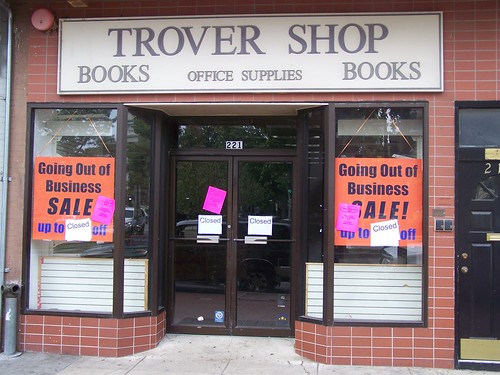Commercial retail rents #2

Trover Book Shop on Capitol Hill is now closed.
Last week, I blogged about the Post article about vacancies in Cleveland Park, in "Cleveland Park Retail: My off-hand evaluation, the rents are too high." (Also see the follow up letter to the editor in the Post, by a former DC planning official, "Room for Change in Cleveland Park.")
Greater Greater Washington calls our attention to four other bloggers (Felix Salmon of Reuters, Matt Yglesias, Sommer Mathis of DCist, and Ruth Samuelson of the City Paper) writing about the same issue, if not the same situation. Except for the Reuters writer, the other writers don't appear to have a good handle on the economics of retail/small business.
The point I was making is that what a business can pay in rent is linked to the profitability of the business, based on the square footage of the store/restaurant and the sales per square foot, along with the rent metric of paying no more than 4% to 15% (for restaurants) in gross revenue on rent.
So a 2,000 s.f. space with revenues/s.f. of $500 (which can be double what a typical retailer grosses, most do under $300/s.f.) yields $1 million/year in gross revenue.
Affordable rent varies from $40,000 (at 4%) to $100,000 (at 10% of gross revenue). That works out to $20 to $50/s.f. respectively. If sales are half that, so is affordable rent--$10/s.f. to $25/s.f. Etc.
The asking prices for retail space in most of DC's commercial districts, even those that are significantly underperforming (in marginal commercial districts like H Street or Brookland asking prices are at least $30-$35/s.f., for buildings that are usually substandard, requiring a great deal of tenant improvements, with limited "concessions" from the landlord for build out allowances), are not economic for independents, and for the most part, chains aren't interested in the space.
Hence, vacancies.
I was talking about Cleveland Park with a Main Street manager in Maryland, and she pointed out how in her community, with revenues down, property owners are working with the tenants on rates to keep the businesses open.
This made me realize something that I forgot to mention wrt Cleveland Park, that as more property gets acquired by national property companies like Federal Realty, you lose that kind of informal flexibility that exists in commercial districts where the property is owned by local interests.
As an alternative, see "Giving tenants a break at Main Street" from the Burlington Free Press. From the article:
Main Street Landing has been involved in environmental and socially-conscious redevelopment since the early 1980s. They have completed over 250,000 square feet of new and renovated space, which includes the Union Station, CornerStone, Wing and Lake & College Buildings.
This past year Main Street Landing waived all of its tenants' rent and triple net increases for the year in order to help them weather the economic storm. The owners also assisted some of their tenants in downsizing their spaces to help reduce their expenses.
"We wanted to show our tenants that we care about their success, and we wanted to give them a bit of a lift until the economy rebounded," said Moulton, CEO and redeveloper of Main Street Landing.
Something else that I was thinking about wrt Cleveland Park, but generally, is how most DC commercial districts (except for Business Improvement Districts) do very little in the way of marketing and promotion. I doubt that there is a retail merchants association in Cleveland Park with the kind of heft that the Carytown Merchants Association has in Richmond. (In Carytown, by the way, the prevailing rents top out at about $25/s.f.)
That's not the case in other cities like Seattle, Portland, the various boroughs of Manhattan, etc., where they is support at the city level for the production of brochures and maps for local commercial districts.
For example, Hampden, a commercial district in Baltimore, has a great customer-focused business directory-brochure/map. (Although their website isn't that great, on the other hand, websites like In Ballard, for the neighborhood/commercial district in Seattle, are quite good. But there are many good examples across the country. I am even fond of the Elmwood Village site from Buffalo, New York.)
There are a lot of other things that push up rents for commercial retail, because the system is oriented to chains ("credit tenants") and they have many advantages that independent stores are not benefiting from.
Plus there is the issue of the regulatory burden, which can be particularly onerous for independents. The Claremont Institute (when I was in college I never thought I would be quoting favorable from "conservative" think tanks) has an interesting article about this, "Lattes at the Regulatory Cafe," which states:
As the ordinances and laws that affect businesses grow, larger companies that are much better equipped to handle the complexities of these regulations have a decided advantage over smaller, single-store operators. And government leaders at every level—through ever-expanding regulatory, tort, and tax laws—continue to unwittingly shift the advantage to the big players. Any small business owner could explain why.
Even a lemonade stand in Anytown, CA technically requires a business license, a visit from health inspectors, and a permit from the planning commission before it opens. A coffee shop presents a more daunting challenge—there will need to be bathrooms accessible to the handicapped, workplace safety rules posted on the wall, and liability insurance should a customer scald herself on a chai mocha.
"Reducing regulatory costs would help the independent business more than the chain, because it's a bigger percentage of their costs," Southern California economist John Husing said. "Chains can more easily bear high startup costs and short term losses given the staying power their financial resources afford."
Labels: commercial district revitalization, formula retail, planning for complete places, restaurants, urban design/placemaking, urban revitalization, zoning



1 Comments:
A debt of gratitude is in order for your glorious posting! I very delighted in understanding it.
Post a Comment
<< Home